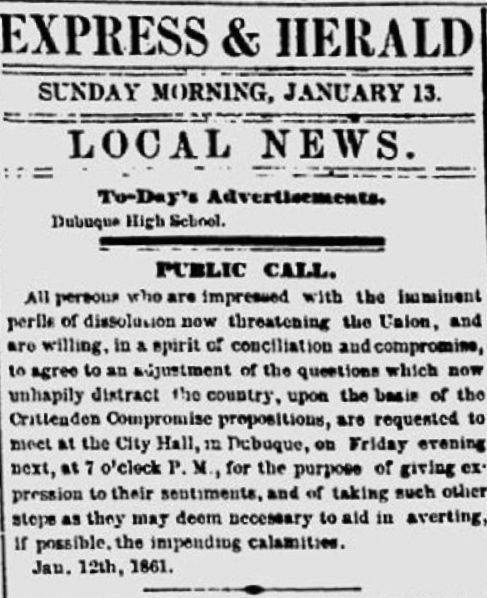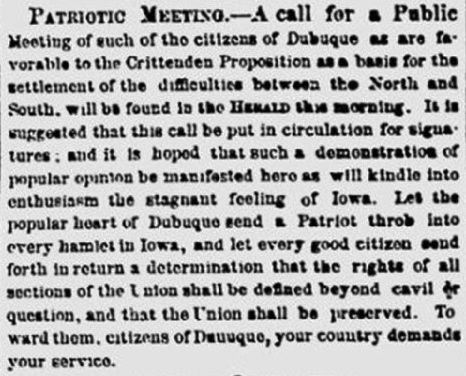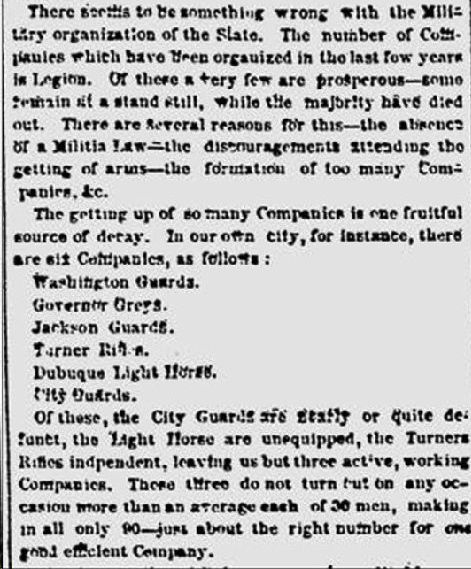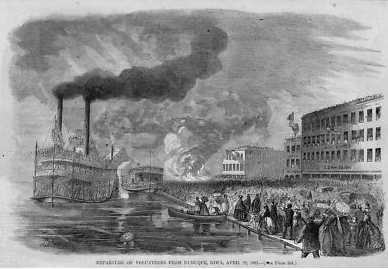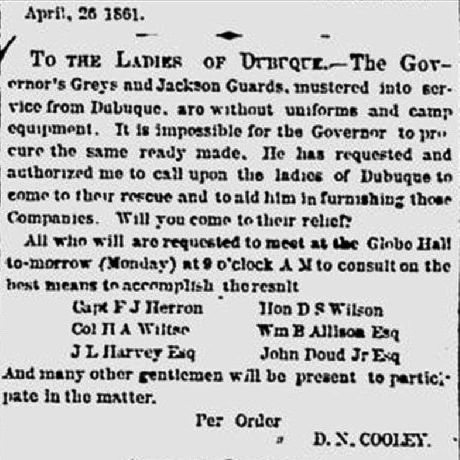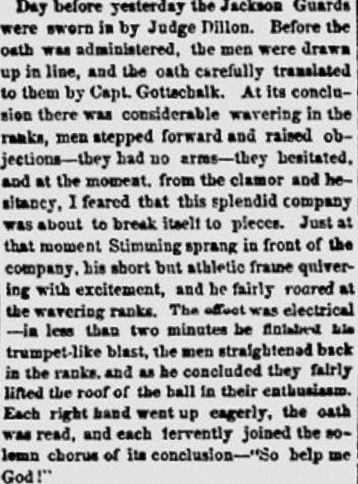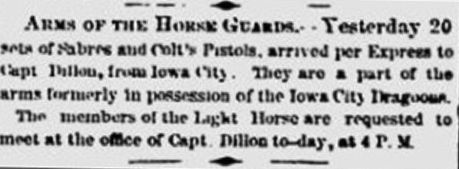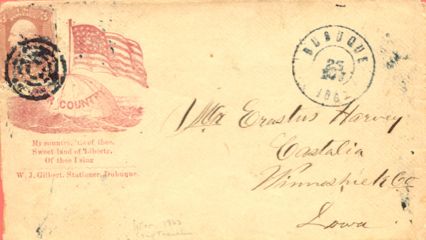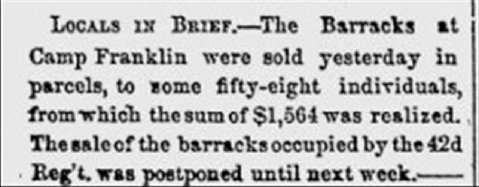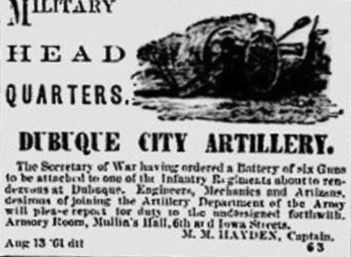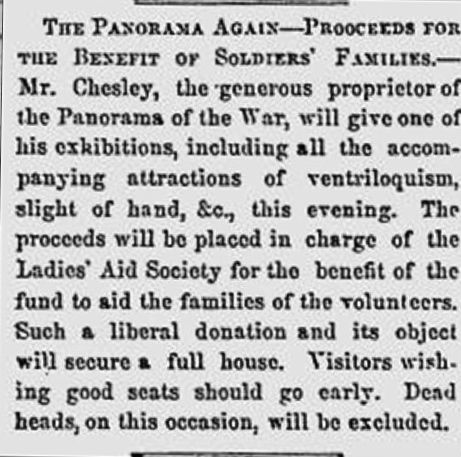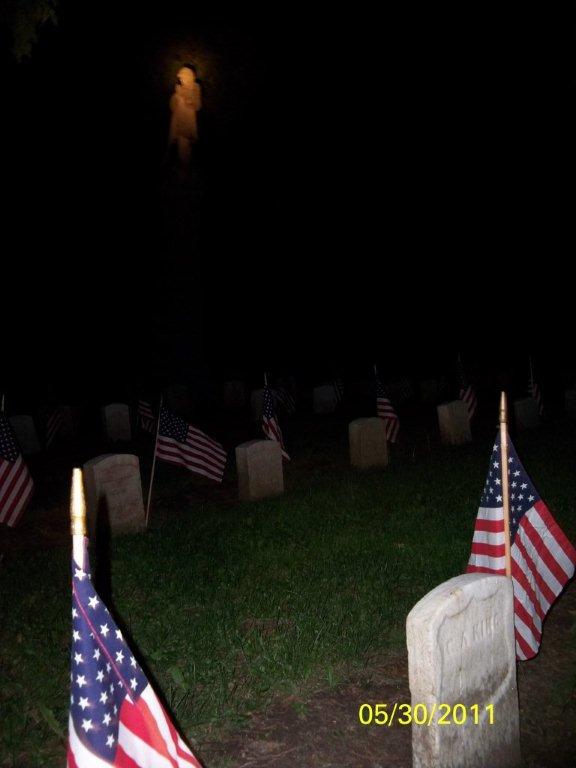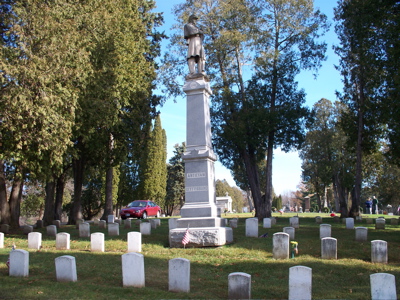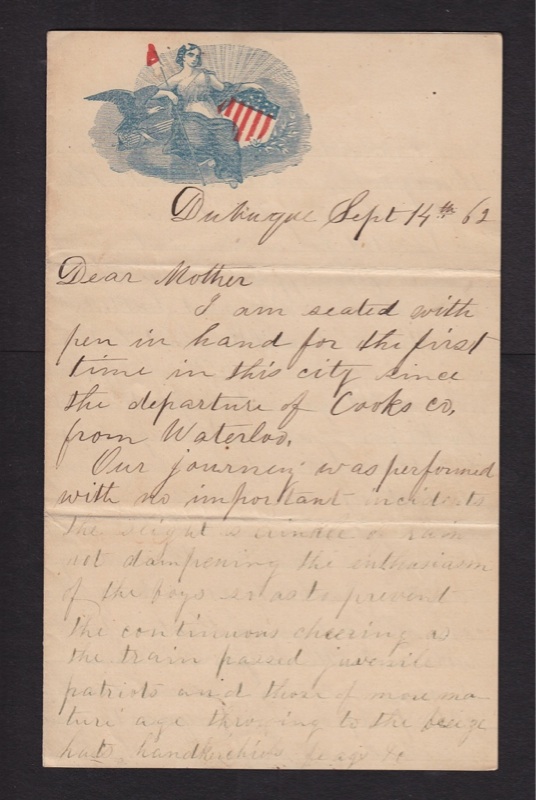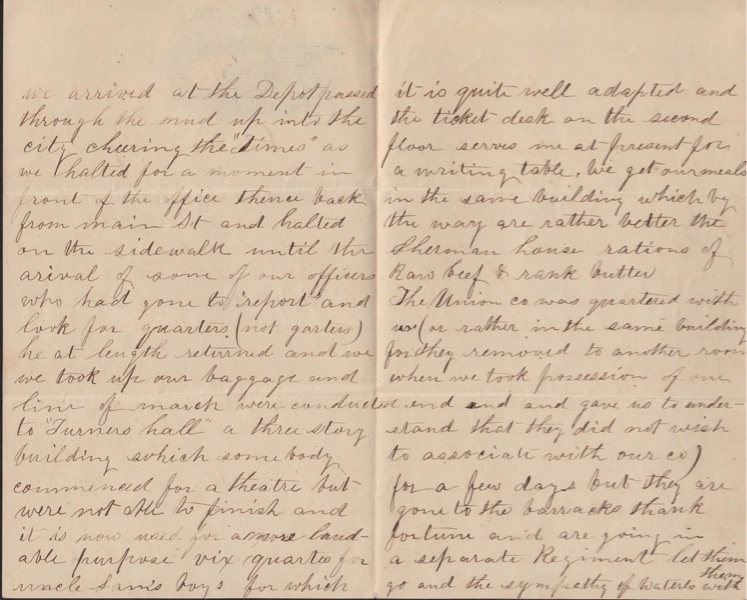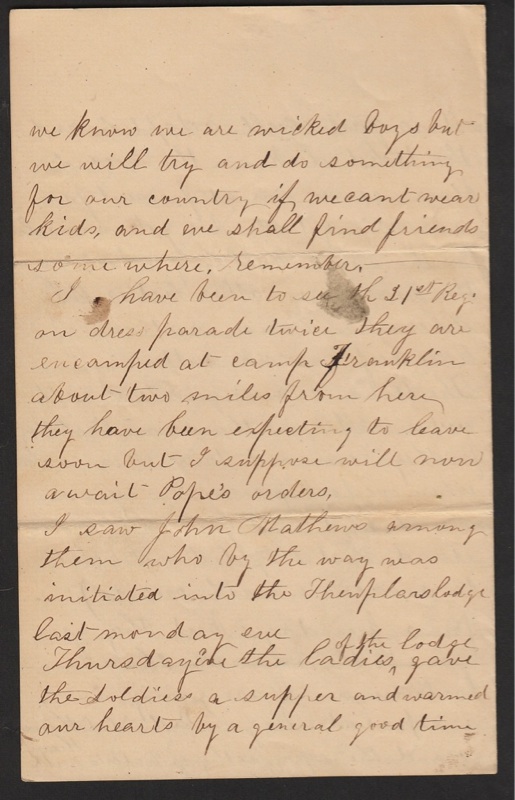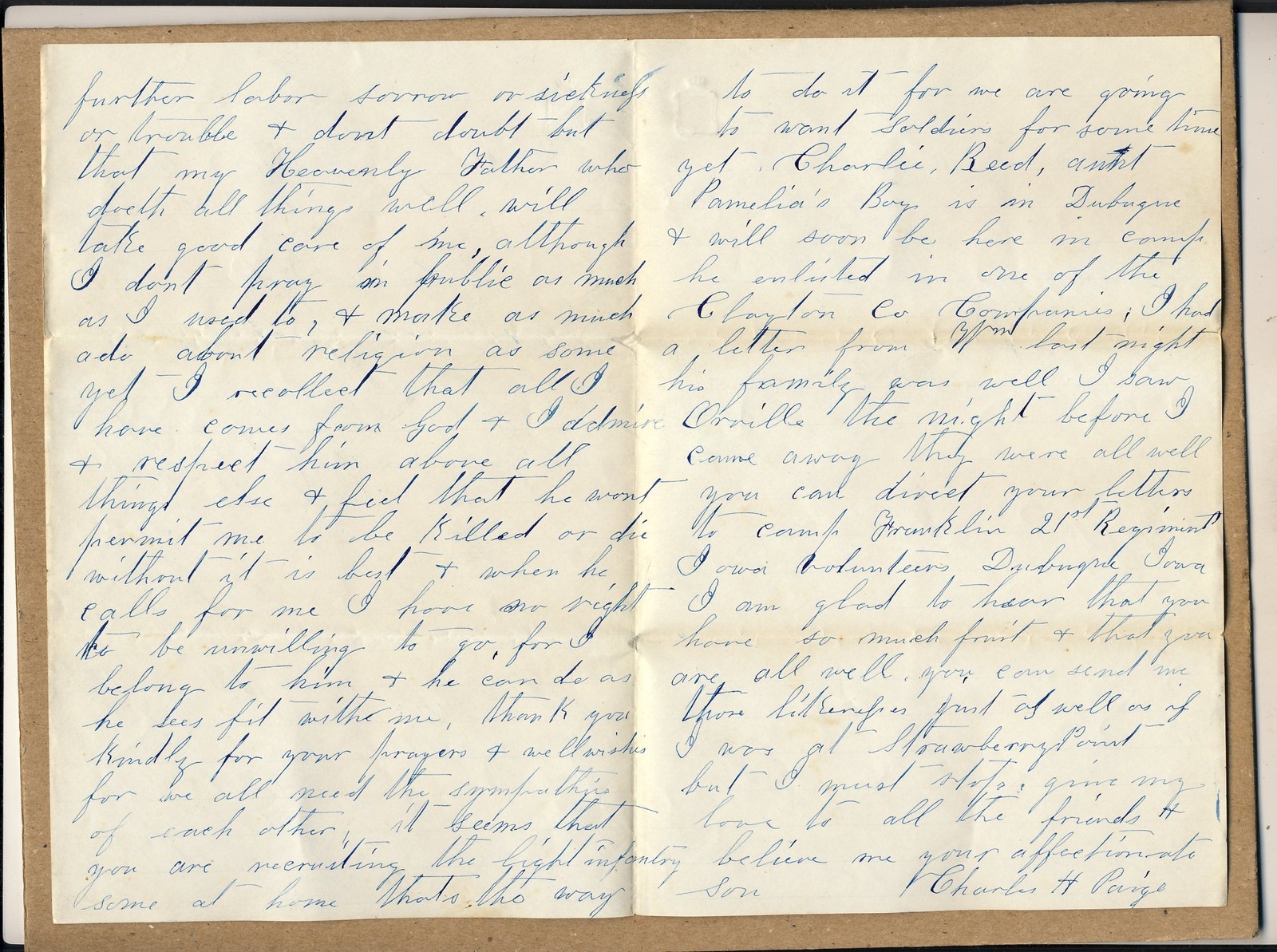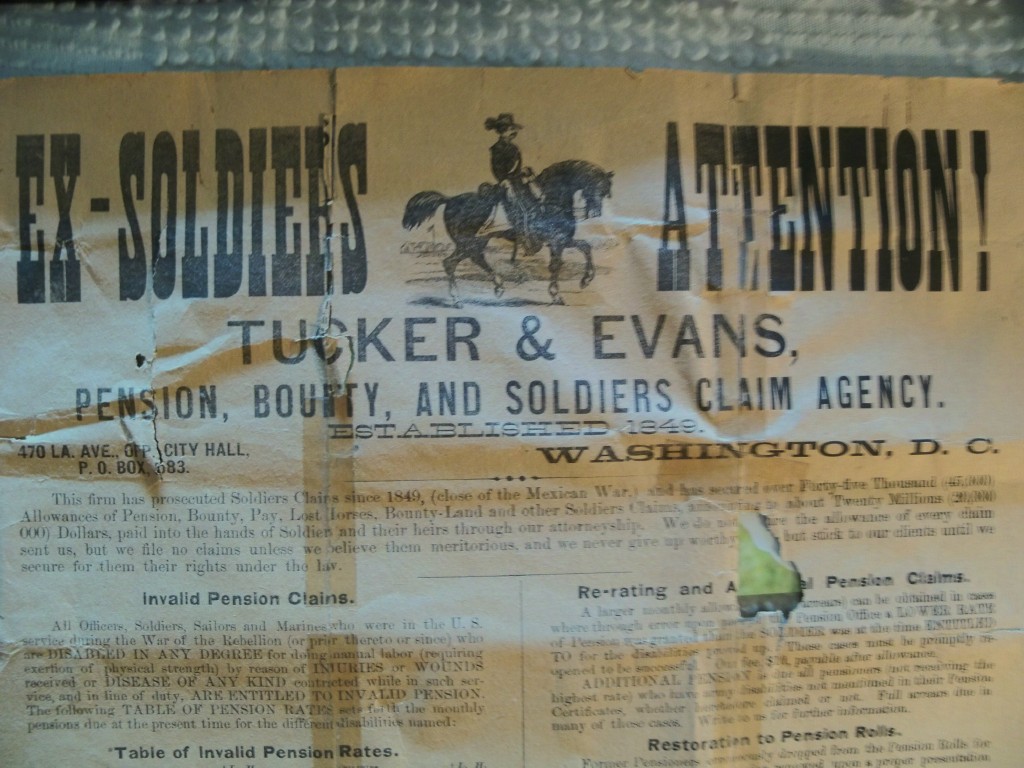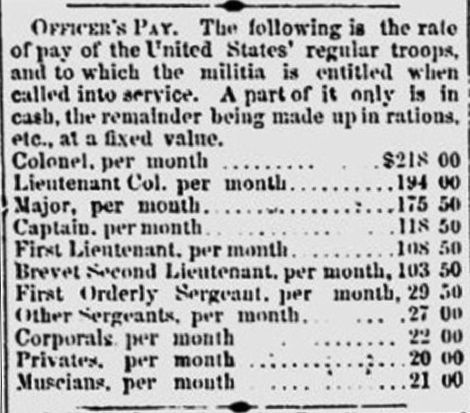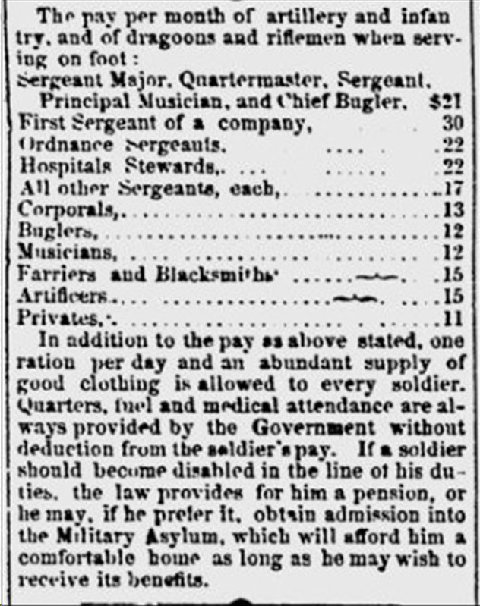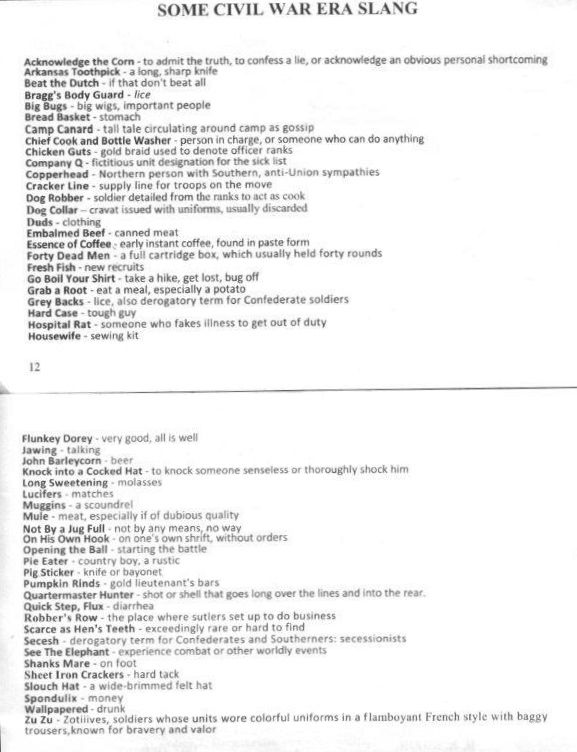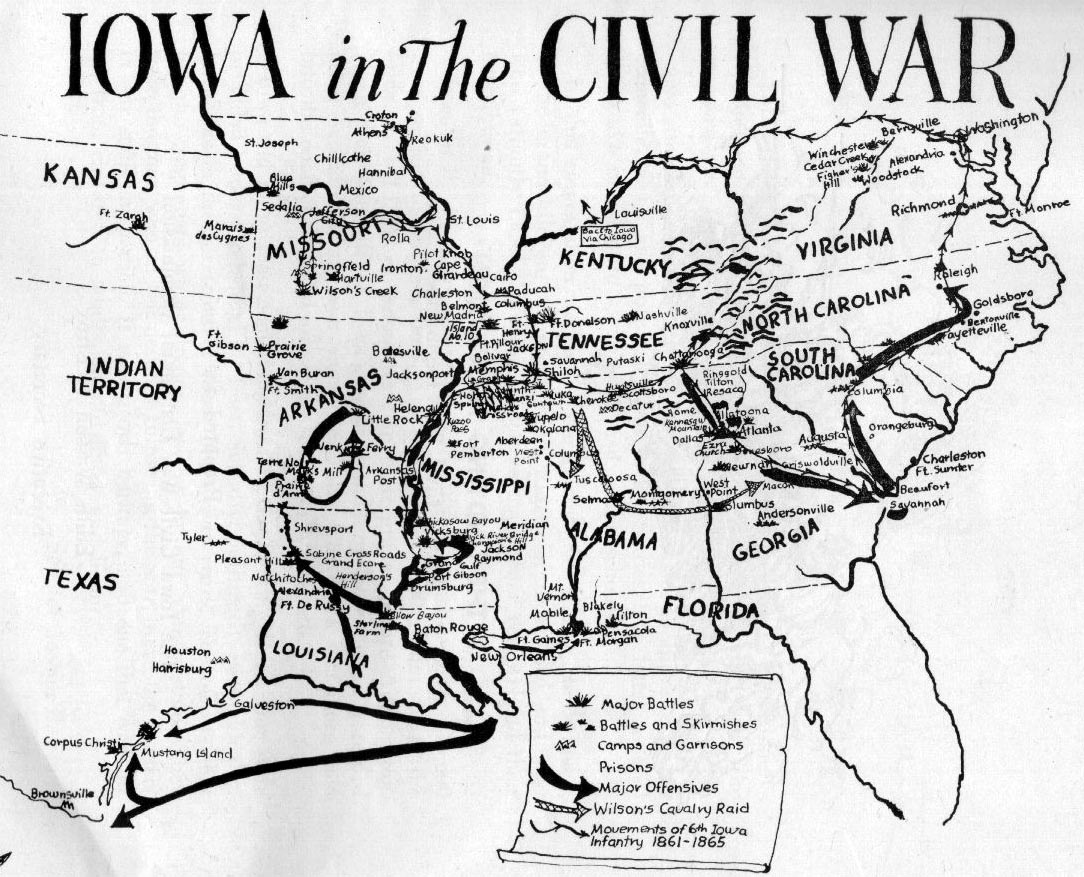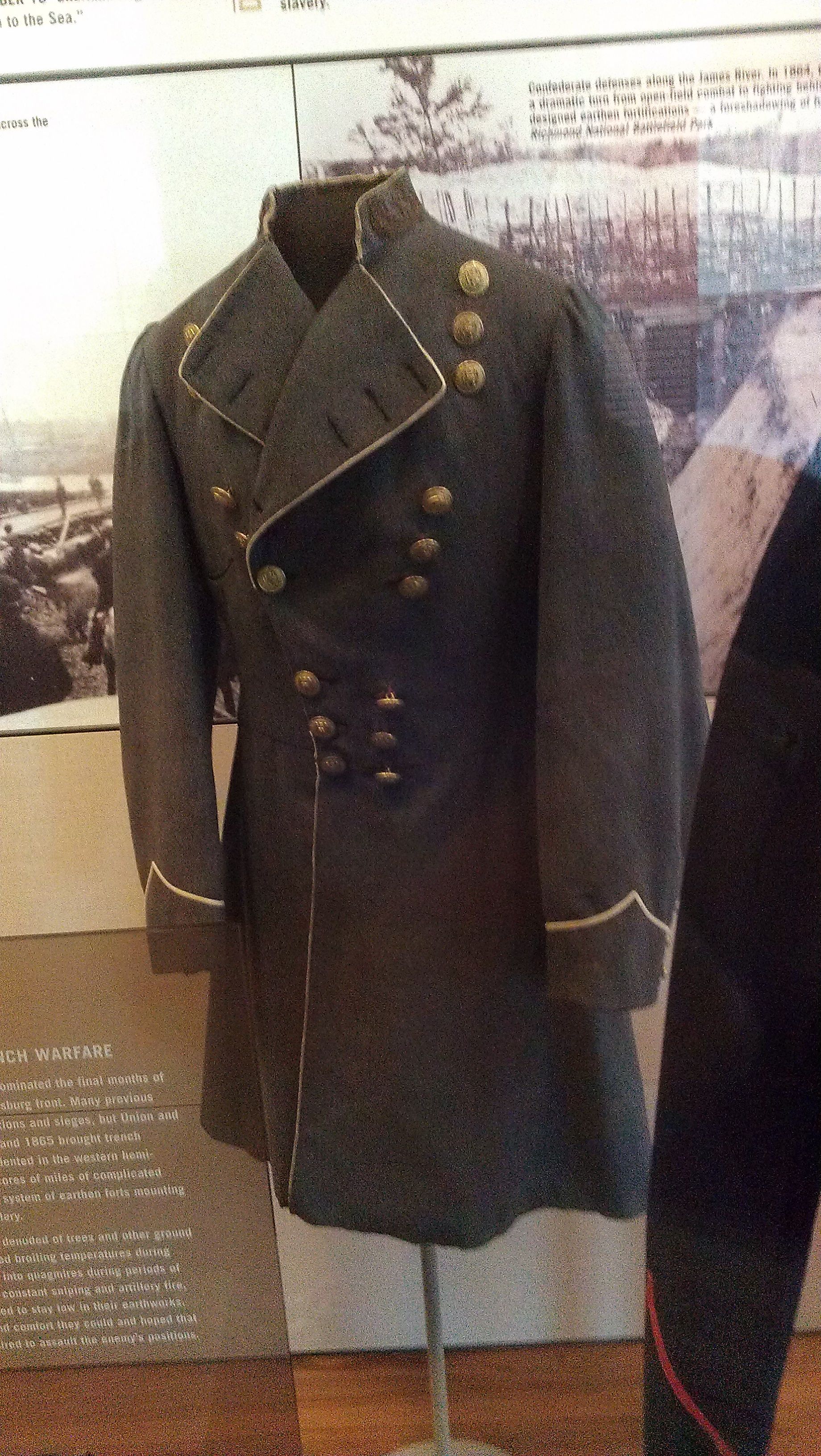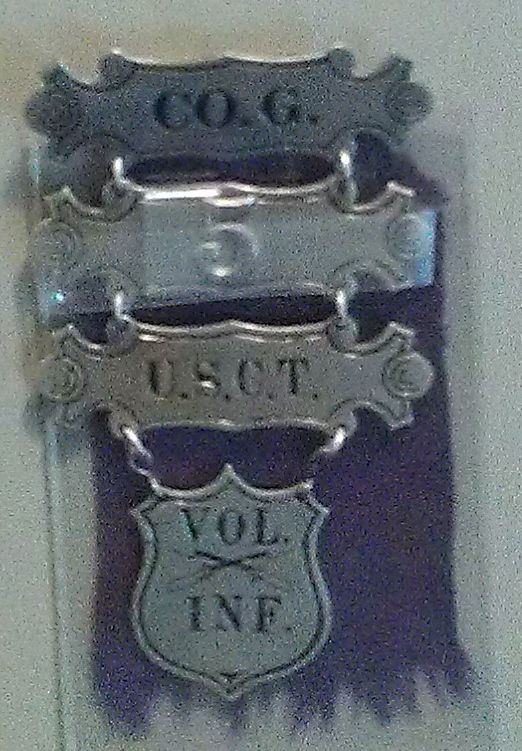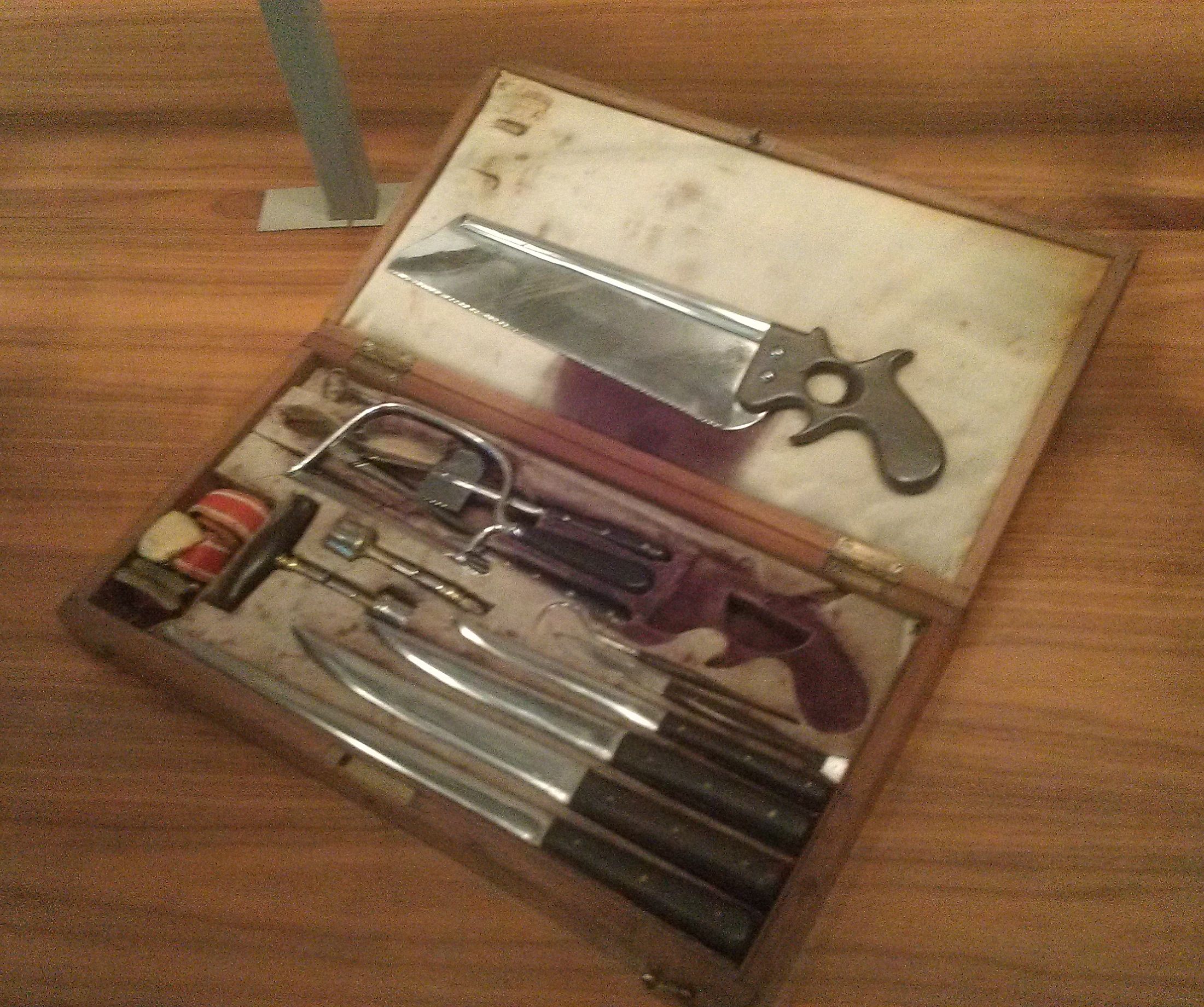Encyclopedia Dubuque
"Encyclopedia Dubuque is the online authority for all things Dubuque, written by the people who know the city best.”
Marshall Cohen—researcher and producer, CNN
Affiliated with the Local History Network of the State Historical Society of Iowa, and the Iowa Museum Association.
CIVIL WAR: Difference between revisions
No edit summary |
No edit summary |
||
| Line 117: | Line 117: | ||
[[Image:slang.jpg|left|thumb|350px|This list is provided by Diane Harris from a genealogy newsletter.]] | [[Image:slang.jpg|left|thumb|350px|This list is provided by Diane Harris from a genealogy newsletter.]] | ||
[[Image:war_map.jpg|left|thumb|350px|Iowa in the Civil War. Photo courtesy: Iowa National Guard]] | [[Image:war_map.jpg|left|thumb|350px|Iowa in the Civil War. Photo courtesy: Iowa National Guard]] | ||
[[File:frockcoat.jpg|200px|thumb|right|Photo courtesy: Tredegar Museum, Richmond, Virginia. Confederate general's coat.]] | |||
[[File:coloredtroops.jpg|200px|thumb|left|Photo courtesy: Tredegar Museum, Richmond, Virginia. Insignia worn by (CT) "Colored Troops"]] | |||
[[File:surgeonscase.jpg|200px|thumb|right|Photo courtesy: Tredegar Museum, Richmond, Virginia. Surgeon's equipment.]] | |||
[[File:cannon.jpg|200px|thumb|right|Photo courtesy: Tredegar Museum, Richmond, Virginia. Confederate cannon manufactured by the Tredegar Company. On the left a 42-pounder rifled and banded siege cannon. On the left Model 1841 6-pounder field cannon and thought to be the first bronze cannon manufactured at this site.]] | |||
Revision as of 21:48, 29 September 2013
See the category--Civil War Sketches
See: AFRICAN AMERICANS
CIVIL WAR. The American Civil War was a struggle fought within the United States from 1861 until 1865 with such complex political, economic, psychological and social causes that reasons for the conflict remain a source of disagreement among historians.
Sincere efforts were made nationally and at the nation level to avoid armed conflict.
By 1861, however, many military companies had been organized in Dubuque: the DUBUQUE CITY GUARDS, the Turner Rifle Company, the GOVERNOR'S GREYS, the JACKSON GUARDS, the DUBUQUE LIGHT HORSE GUARDS, UNION GUARDS, DUBUQUE LIGHT ARTILLERY, and the WASHINGTON GUARDS.
The number of military groups was a concern for some residents. (See editorial on right)
With the firing upon Fort Sumter, President Abraham Lincoln called for volunteers. The first Iowa Infantry regiment was formed in Dubuque under the leadership of Colonel John F. Bates. This was the first Iowa unit established under Lincoln's call for volunteers on ninety-day service. Later regiments were formed of men volunteering typically for three years.
The call-up of volunteers brought tension to Dubuque. Iowa Catholics especially in Dubuque were not generally supporters of the war. Bishop Mathias LORAS owned a slave. Other Catholic bishops while insisting that slave owners treat their slaves in a humane manner seemed to accept the practice as a part of Southern society. Traditionally Democratic, Dubuque Catholics supported Democratic candidates in 1860. Patrick J. QUIGLEY and George Wallace JONES committed themselves to the Democratic candidate, Breckenridge. Dennis MAHONY, an influential lay leader in the church, teacher, state legislator, and newspaper editor chose to support Illinois Senator Stephen Douglas. While Lincoln carried the state in the election of 1860, Dubuque and Lee counties, voted Democratic. Mahony's editorials became so extreme that he was arrested without a warrant and jailed without a trial as a means of quieting opposition to the war.
Iowa Catholics also had reservations about the new Republican Party. Formed just before the election of 1860, this political group included anti-Catholics such as the former Know-Nothings. The DUBUQUE OBSERVER came into existence in 1854 with a definite hostility to the Irish and foreign born and a suspicious attitude toward Catholics. A belief at the time was that a Catholic conspiracy existed which was attempting to bring down the Republic and the Constitution.
Given the strong pro-Southern leanings of many of the citizens, Bishop Clement SMYTH took a decidedly different approach. The bishop strongly condemned the activities of the COPPERHEADS and threatened excommunication of any Catholics who joined. He called upon the foreign born not to do anything that would suggest they were disloyal and openly expressed grief at the death of Lincoln at the end of the war.
In proportion to its population, Iowa furnished more men to the war effort than any other state. Two Dubuque companies were the Governor's Greys led by Captain Fredrick Gottschalk and Captain Francis J. HERRON and the Jackson Guard. Only four of the Jackson Guards were native-born Americans. The other members of the company were immigrants from Prussia, Bavaria, Switzerland, Austria, Ireland, Luxembourg, and nine German states. The Governor's Greys were primarily native-born Americans with nearly half of the company originally from New York and only five natives of Iowa. There were fifteen foreign-born members of the group.
On April 22, 1861, the companies departed Dubuque for Missouri aboard the ship the Alhambra in a scene illustrated by Alexander SIMPLOT. The Dubuque Herald on April 23, 1861 noted that volunteers were walking as far as twenty-five miles to come to Dubuque to volunteer. Pro-war sermons were preached by ministers of the Baptist and Congregational Churches. Classes at Catholic schools were dismissed, and Bishop Smyth flew the Stars and Stripes. Led by the GERMANIA BAND, the companies marched to the boat at the base of Jones Street.
Uniforms for the soldiers, despite valiant efforts of the Ladies Volunteer Labour Society (see the editorial on the left), were not complete and were sent two weeks later.
Supplying weapons for the troops also proved difficult. (See article on the right.) Captain R. G. Herron returned from Springfield, Illinois on May 4, 1861. He had been sent by Governor Kirkwood to requisition 5,000 "stands" of arms. He found nothing but old flintlocks which had been refitted into percussion arms. There were bayonets but no scabbards. He refused all of the equipment. Military weapons, however, were on their way from Chicago according to the Dubuque Herald.
On August 10, 1861, Dubuque troops fought at the Battle of Wilson's Creek in southwestern Missouri near Springfield. They were defeated in their mission to control the area for the Union. The bloody battle, which lasted only one morning, led to the death of 30 percent of the Jackson Guards and 23 percent of the Governors' Greys whose uniforms unfortunately led many to be mistaken for Confederates.
Eleven days after the battle, one-fourth of the Jackson Guards and half of the Governors' Greys re-enlisted. In 1862 Captain Herron became the youngest major general of the Union Army. Hennan H. Heath, not present at Wilson's Creek, became a one star general.
Immediately after the firing on Fort Sumter there was a bi-partisan effort among Republicans and Democrats to preserve the Union. Church leaders attempted to calm their congregations. (Oldt, p. 258). On April 15 a public meeting was called for the purpose of securing an expression of opinion favoring the support of the government against the secession movement. (Oldt, p. 258) After the adoption of several resolutions, the meeting continued to grow in size and loyalty. During the speaking, any remarks not agreeing with the resolutions were met with hisses. (Oldt, p. 259).
Dennis MAHONY, editor of the Dubuque Herald, wrote to Governor Kirkwood and offered to recruit and lead an Irish regiment. His offer was not accepted. Other efforts by Democrats to join in the war effort were also rejected, an action that has led some historians to suspect the Republican Party of attempts to gain a partisan victory from the war with political and economic benefits. The conflict over the Civil War was carried out locally through the NEWSPAPERS. The editor of the Dubuque Times, a staunchly Republican publication, even suggested that if Democrats really wanted to cooperate in the war effort they would join the Republican Party.
Most Northern Democrats did support the war effort, earning the title "War Democrats." Other Democrats came to oppose the war and earned for themselves the term "Peace Democrats." Dubuque also had its southern sympathizers. Senator George W. Jones and former Governor Stephen HEMPSTEAD had sons in the Confederate army. Jones, a life-long friend of Confederate President Jefferson DAVIS and United States ambassador to Columbia, was arrested upon his return to the United States in part because of indiscreet letters he had written Davis prior to the Civil War. Jones, his political fortunes ended, raised an uproar by going south to visit Davis after the war and returned in 1899 to attend the funeral of his friend.
Anti-Catholic and anti-foreign attitudes expressed by those who were also anti-slavery angered many Dubuque residents. Republican leaders including President Abraham Lincoln believed that many influential Dubuque citizens were pro-slavery. Dubuque was rumored to be a headquarters of the KNIGHTS OF THE GOLDEN CIRCLE. There was widespread suppression of the press, along with arrests, censorship, and suspension of habeas corpus. It has been said Jones was jailed as much as a warning to powerful Dubuque residents as for his letters to Davis.
Dubuque's principal newspapers bitterly attacked each other's point of view. Accusations made by the Dubuque Times against the Dubuque Herald led Dennis Mahony to charge the paper with libel. The Herald further incited the Times by printing editorials that urged peace and condemned the Lincoln Administration. A riot caused by rumors of a plot to destroy the Herald office was prevented by law enforcement officials and the efforts of MAYOR Henry L. STOUT.
Mahony, a bitter opponent to the war, was arrested on August 13, 1862, at his home and jailed in the Washington, D.C. prison without habeas corpus until after the elections in November 1862. Mahony ran for Congress in 1862 from his jail cell against William Boyd ALLISON and carried Dubuque County by nearly a 2 to 1 margin.
Northern Democrats who opposed the Union war policy became known as COPPERHEADS, a name first used in the July 20, 1861, issue of the New York Tribune. Some Dubuque citizens cut the heads from Indian Head cents, which had the word "Liberty" on the headdress, and wore them as badges of honor. Charges of treason were leveled against them.
Dubuque was selected in July 1862, as a rendezvous for regiments raised by a new call from the War Department. Recruiting offices flew flags from nearly every block in the city. Since Dubuque had such an anti-Lincoln reputation, the idea of it being the headquarters for a training center called CAMP UNION made little sense. It was renamed Camp Franklin.
By August 27 Dubuque was the headquarters for 1,700 soldiers. One thousand were quartered at Camp Franklin. Boarding houses and hotels furnished shelter for seven hundred more. By 1863, however, Camp Franklin was discontinued.
The search for more soldiers led to the movement to form an Irish regiment in Dubuque. Service for one year would grant citizenship to foreigners. Those who joined were attached to General Corcoran's Irish Brigade. A special Christmas dinner for the volunteers and others stationed by Camp Franklin came from local ladies who sent pies, cakes and supplies of turkeys to the soldiers.
Dubuque became recognized as one of the Union's best recruiting centers. Recruiting officers offered the usual bounty of one hundred dollars and the first month's pay in advance. Lieutenant Dewey, one of the most successful recruiters, enlisted five hundred men in one year. Dubuque soldiers enlisted within Iowa as well as in other states. In 1862 a draft was not needed to fill the quotas of soldiers needed. As late as 1863, bounties as high as $302 for new recruits plus clothing allowance and regular pay and $402 for veteran soldiers were useful in filling the recruitment requirements. Iowa was the only state to organize a group of older men for service; this was the GRAYBEARD REGIMENT which included several Dubuque residents.
Soldiers from Dubuque were active in the final campaigns of the war. They saw action along the Rio Grande, in Mississippi, Georgia and Tennessee. At the same time, recruitment became more difficult. Obtaining substitutes to avoid conscription became more common with offers ranging from $200 to $400. A brokers' association formed in Dubuque furnished substitutes. Members each paid $250 to have a substitute for one year. If the member was not drafted his fee remained in the association. In 1864 a special tax was levied by the Board of Supervisors to relieve Dubuque County of the draft. A total of $125,000 was appropriated to secure volunteers who would enlist giving credit to Dubuque County. Scores of men flooded to Dubuque although each was to be paid no more than $400. The total amount paid out reached $115,800.
During the war, many military companies were organized in Dubuque. In 1864 soldiers joined the Key City Guards, Key City Battery and the Union Guards. Interest in military life had by now, however, weakened substantially. Adjutant General N. E. Baker had to issue an order that military companies had to drill a minimum of once per month or their equipment would be taken away.
Sacrifice on the battlefield was matched by determined assistance from those left at home. Under the leadership of Mrs. James Langworthy, Mrs. Henry L. Stout, and Mrs. J. W. Taylor, the Ladies' Volunteer Labour Society in Dubuque made uniforms for the Jackson Guards and the Governor's Greys in 1861. Boxes of clothing and food were sent to soldiers in the field throughout the war. The Society met in the basement of the Baptist Church. Annual membership dues were twenty-five cents. Donations of knitting, sewing, money, and food were accepted. Christmas dinner was provided every soldier's family in Dubuque in 1863.
Fund-raising was an important activity of the Society. By 1864 an estimated sixty-two families were entirely dependent on the Society for support. In addition to the dues, the Society served breakfast and refreshments at the Iowa State Agricultural Fair in 1864. This activity, in addition to providing an evening benefit entertainment, earned the Society $1000. Collections were also taken in church. Local festivals and balls earned hundreds of dollars.
Other community efforts to help in the war effort included the Christian Commission Society. Organized on November 21, 1864, the agency met the needs of the church in distributing food and spiritual needs to military personnel. Representatives were sent to every army with supplies and Bibles. In 1863 efforts were started to establish a Soldiers' Home in Dubuque. Since it helped soldiers from counties outside of Dubuque, financial assistance was sent from boards of supervisors in Blackhawk, Bremer, Butler, Chickasaw, Delaware, Floyd, Jones and Mitchell counties. Over one thousand soldiers were aided within one year.
News of the occupation of Charleston by Union troops and the surrender of General Robert E. Lee were causes of joyous celebration. Flags were displayed on February 22, 1865, to celebrate the Charleston victory, and Captain Oliver Perry SHIRAS ordered a salute fired with one hundred guns in WASHINGTON PARK.
News of Lee's surrender reached Dubuque on April 8, 1865. Church bells pealed the glorious news. The bell on the FIRST CONGREGATIONAL UNITED CHURCH OF CHRIST rang so long it cracked. Flags were displayed everywhere. Those excessively patriotic dressed themselves in national colors and paraded through the streets.
The Civil War led to the deaths of 3,540 in combat; 8,498 of disease; 515 in prisoner-of-war camps; 227 in accidents; and 221 from nonmilitary causes. There were 8,500 reported wounded. In 1893 Dubuque's monument to her Civil War dead was erected in LINWOOD CEMETERY after twelve years of collecting funds.
See: DAUGHTERS OF UNION VETERANS OF THE CIVIL WAR 1861-1865
See: SONS OF UNION VETERANS OF THE CIVIL WAR
---
Source:
Dubuque Herald, April 13, 1861
Dubuque Herald, April 23, 1861
Dubuque Herald, May 5, 1861
Gallagher, Mary Kevin B.V.M. Seed/Harvest: A History of the Archdiocese of Dubuque. Dubuque, IA: Archdiocese of Dubuque Press, 1987
Harris, Diane
Oldt, F. T. (editor) History of Dubuque County, Iowa 1911.
Pregler, John.


